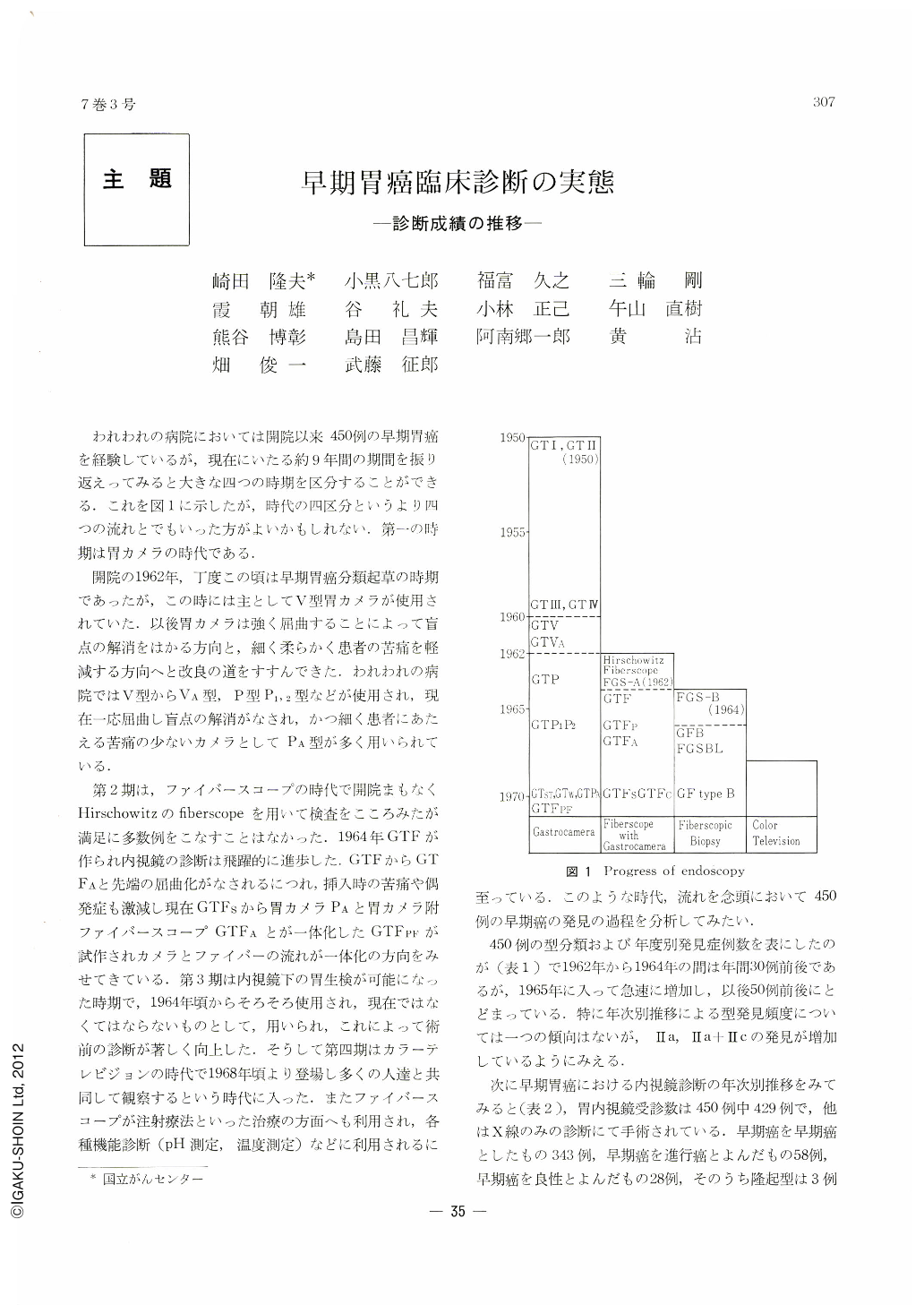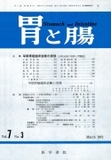Japanese
English
- 有料閲覧
- Abstract 文献概要
- 1ページ目 Look Inside
われわれの病院においては開院以来450例の早期胃癌を経験しているが,現在にいたる約9年間の期間を振り返えってみると大きな四つの時期を区分することができる.これを図1に示したが,時代の四区分というより四つの流れとでもいった方がよいかもしれない.第一の時期は胃カメラの時代である.
開院の1962年,丁度この頃は早期胃癌分類起草の時期であったが,この時には主としてV型胃カメラが使用されていた.以後胃カメラは強く屈曲することによって盲点の解消をはかる方向と,細く柔らかく患者の苦痛を軽減する方向へと改良の道をすすんできた.われわれの病院ではV型からVA型,P型P1,2型などが使用され,現在一応屈曲し盲点の解消がなされ,かつ細く患者にあたえる苦痛の少ないカメラとしてPA型が多く用いられている.
Results of endoscopic diagnosis for 450 cases of early gastric cancer are studied that have been encountered during the past nine years since this hospital was opened. For convenience' sake, these years are divided into four periods; gastrocamera, fiberscope, gastric biopsy and color TV.
The opening of our hospital in 1962 was soon followed by the advent of GTF and the practical use of gastric fiberscopy in 1964. Improved diagnostic technics can be seen in the great difference of diagnostic accuracy between the period 1962~1964 and thereafter. Yearly detected cases rose up from 30 to 50 in number. Preoperative diagnosis also reached to almost 100 per cent accuracy since 1969. All these figures corroborate the importance of gastric biopsy in the diagnosis of early gastric cancer.
Endoscopic diagnosis itself prior to biopsy also shows a far better results after 1964. This is certainly due to the use of fiberscope. However, when the results of endoscopy before and after the introduction of fiberscope are compared, only slight progress is seen after the use of fiberscope was established. Year by year there still remain some cases endoscopically negative to be later confirmed as early cancer through biopsy. All these cases presumably represent those that are hard to diagnose unless biopsy is employed, and in all probability they might have been overlooked if they had been examined at a time when as yet biopsy was not a routine procedure. Recently we make it a rule to perform biopsy not only on cases labelled as “probably benign” but also on cases already confirmed as benign.
Comparison of the results in the endoscopy diagnosis with those of biopsy diagnosis shows that 3 per cent of cases endoscopically diagnosed as benign prove to harbor malignancy. On the other hand,30 per cent of cases with endoscopic evidence of cancer later turn out benign after all. This discrepancy may represent an attitude of endoscopists not to overlook any malignancy, but same time it possibly indicates easy-going preparedness on the part of endoscopists to rely too much on the final verdict of gastric biopsy, so that a tendency has arisen not to perform endoscopy earnestly enough. In this respect grave reflection is called for. As is apparent in the yearly results of gastric biopsy for early cancer, its technics have been so much improved since 1968 that negative results are hardly observed thereafter. Since there are cases initially negative for cancer that become later positive by second biopsy, it should be repeated on all suspicious negative cases.

Copyright © 1972, Igaku-Shoin Ltd. All rights reserved.


